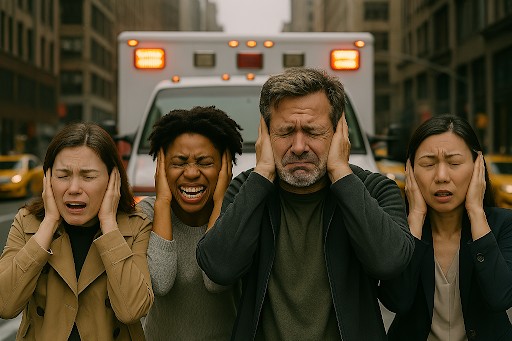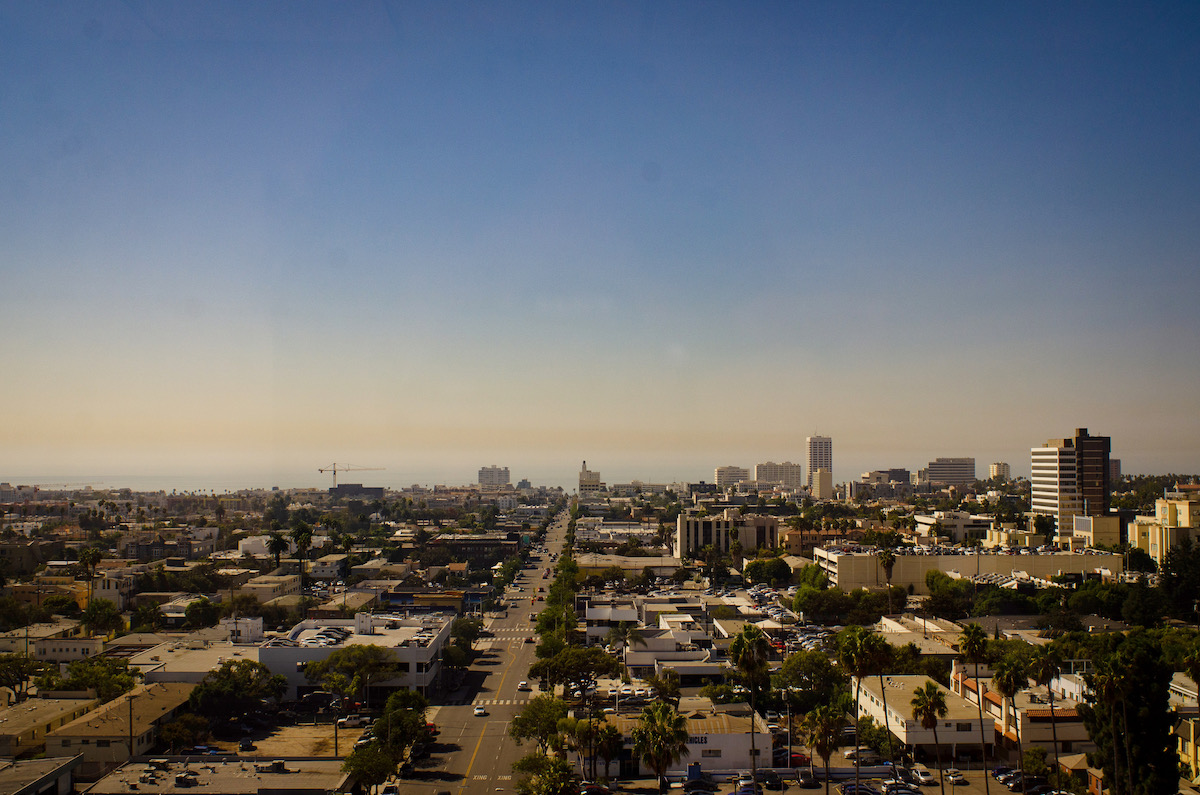
In today’s cities, silence isn’t golden—it’s extinct.
From sunrise to insomnia, we’re trapped in a nonstop symphony of shrieking car alarms, roaring leaf blowers, and sirens that sound like the sky’s being torn in half. This isn’t background noise—it’s a full-throttle sonic assault. And your body, whether you’re paying attention or not, is taking the hit.
Of course, it’s easy to say that Santa Monica has far greater problems to solve besides this right now. Still, it’s something that should not be ignored, because with increasing density and development, this issue will only exacerbate. Let’s review the repeat offenders:
Louder Than Necessary, Useless by Design
Car Alarms:
Once intended to deter car thieves, they now mostly punish innocent bystanders. They howl for minutes, triggered by the rumbling of a bus or the passing of a bass speaker. No one checks. No one cares. They’re the crying wolf of the modern city—only louder and more obnoxious. Hey, here’s an idea? Why not have an app notify you individually, rather than the entire population within a one-mile radius? And you can turn it off remotely! You don’t need AI to understand that makes sense.
Sirens:
We get it—emergencies are urgent. But do we need sirens so loud they rattle your fillings? Europe uses two-tone, low-frequency alerts that inform instead of assault. Meanwhile, American cities still sound like the soundtrack to a panic attack, and I imagine these sirens have started a few of them! There are better options.
Construction, Delivery Trucks, and Mechanical Equipment:
Add to that the invisible orchestra of 24/7 construction noise, idling delivery trucks, and building HVAC systems that roar and hum through the night like industrial whales bellowing to each other. In many cities, these mechanical aural offenders run unchecked and unsupervised, hammering, drilling, beeping, and blasting long after the bars have closed. Without strong noise curfews, proper mufflers, and timed delivery limits, even your dreams go hiding somewhere else that’s quieter!
Fact: What Noise Does to You (Even When You Think You’re Used to It)
Noise doesn’t need your attention to do damage. It just needs access to your nervous system. And it has it, all day and night.
- Long-term exposure increases stress, blood pressure, and the risk of heart attacks.
- Sleep fragmentation linked to traffic and sirens contributes to obesity, diabetes, and cognitive decline.
- Children exposed to chronic city noise show lower test scores, worse memory, and developmental delays.
- And your ears? They’re shot by age 40 if you live near a major road.
Silence, it turns out, is a public health resource—and we’re running out of it.
Why the Noise Won’t Go Away
Simple: convenience and cowardice.
- Car alarms are outdated tech nobody uses to prevent theft anymore, but they still come standard. Vehicle alarms produce sounds ranging from 90 to 120 decibels, with many new car alarms exceeding 125 decibels — louder than a rock concert.
- Sirens are louder to cut through the noise of noise-canceling headphones, traffic, and TikTok videos. Emergency vehicle sirens operate at around 110-124 dB when measured 10 feet from the source. Fire truck sirens range between 115 and 140 dB. They are loud enough to reach the driver’s side window of civilian vehicles at approximately 110 dBA, penetrating the vehicle and effectively warning the driver.
And here’s a real developing problem:
Santa Monica is increasing density exponentially along major boulevards like Wilshire, Lincoln, and Pico. Luxury apartments, mixed-use developments, and affordable housing units are being constructed at a rapid pace.
This surge in residents and cars, in a city already short on quiet, makes effective noise control not just a luxury but a necessity.
Let’s recall the recent complaints from surrounding neighbors near the Waymo recharging lot on Euclid and Broadway, which are currently causing distress to nearby residents 24 hours a day. This is a good and glaring example of the city’s failure to impose appropriate restrictions on permitted zoning and use conditions. There is no excuse for this to continue. Period!
If Santa Monica wants people to live, sleep, and thrive in these new units and increase housing, then it should stop acting like noise is someone else’s problem. Otherwise, we’re cramming thousands more people into buildings that might as well be constructed in the middle of a freeway median.
And speaking of freeways, Santa Monica urgently needs to invest in modern sound barrier walls along the I-10, particularly in the Pico Neighborhood and areas east of 20th Street, where thousands of residents live just yards from the roar of six-lane traffic, with no walls or protective buffers. These aren’t just for noise; they also help reduce air pollution from heavy traffic, shielding nearby homes, schools, and parks from the constant onslaught of engine growl, brake screech, and diesel exhaust.
Santa Monica Noise Standards vs. Real-World Levels (approximate values only)
This matters because every 10 dBA increase feels roughly like doubling the loudness!
| Location | Noise Standard (Exterior) | Measured / Reported Ambient Levels |
|---|---|---|
| Residential areas | 50–55 dBA | Next to I-10 (Pico Neighborhood): 65–70 dBA typical for busy freeways |
| Pico Blvd (adjacent to school zones & dense housing) | 50-65 dBA | Residents report persistent motorcycle and traffic noise at 70+ dBA nightly |
| Wilshire Blvd (high-traffic thoroughfare) | 60-65 dBA | Decibel spikes reported at 70–80 dBA |
| Main Street (downtown/residential mix) | 50–55 dBA | Ongoing complaints about loud vehicles revving into the night |
| Construction on residential parcels | Standard +20 dBA during allowed hours (8 am–6 pm) | Violations before 8 am, after 6 pm; jackhammers & saws reported well after curfew |
| Early-morning delivery zones (e.g., Trader Joe’s alley) | 50–55 dBA + nuisance standard | Forklifts and trucks before 6 am loudly waking residents |
Santa Monica should be at the forefront in making these changes, like other cities that turned the volume down.
While noise here continues to thunder, these amazing and progressive cities have decided that enough is enough and have said that’s it and that’s all!
| City | What They Did | Why It Works |
|---|---|---|
| Paris, France | Banned gas blowers and installed noise radar to ticket loud motorcycles and cars. | Tech meets teeth. |
| Barcelona, Spain | Mapped “noise-stressed zones,” restricted nightlife in residential areas. | Data drives rules—and enforcement. |
| New York City | Requires car alarms to shut off after 3 minutes; active noise code enforcement teams. | The law backs the meter. |
| Berlin, Germany | Switched to low-frequency sirens, offers insulation grants for homes near busy roads. | A city that doesn’t scream to function. |
| Tokyo, Japan | Strict commercial and transit-area noise rules, with cultural respect for quiet. | Discipline meets design. |
It’s Not Rocket Science.
Managing volume levels is not overly complicated; it requires implementing regulations that prioritize the well-being of citizens. Here are some ideas on how we can start to address this issue. Local and state governments need to take this seriously and develop manageable solutions.
- Scrap outdated car alarms—and mandate a 3-minute auto-shutoff for current alarms, accompanied by real fines.
- Adopt quiet sirens, like those in Berlin and Paris. Loud ≠ effective.
- Supercharge 311: Accept videos, require action, and publish complaint-response stats monthly.
- Regulate and enforce freight and delivery hours—limit noisy operations (e.g., forklifts) to designated windows, and issue fines for after-hours activity.
- Deploy noise cameras or sensors on Pico, Wilshire Blvd., Santa Monica Blvd., Lincoln, Main Street, and all main entry points to the city to auto-ticket vehicles exceeding limits, similar to the system in Paris.
- Install sound barriers along I-10, with a focus on the Pico Neighborhood and the area east of 20th Street.
- Strictly enforce construction curfews, with real penalties for violations.
- Enhance insulation and noise abatement for new developments along these corridors by utilizing developer impact fees.
Conclusion: The Real Emergency Is the Noise Itself
Santa Monica’s existing noise standards are regularly violated, particularly on the busiest streets and along commercial-residential edges. To protect residents’ health and livability, and to honor the growth and density already built, the city must close these enforcement gaps before booming expansion drowns out our peace entirely.
Without controls, excess noise is the only pollutant that seizes you by the nervous system. It raises your heart rate, shortens your fuse, adds to anxiety, and erodes your sleep.
City governments, developers, and real estate owners need to recognize that cities that become quieter will be the ones people choose to live in, raise families in, and start businesses in. The cities that don’t? They’ll continue to lose their calmest, clearest thinkers to more distant places, which are more tranquil and a little less jarring.
The technology exists. The policies exist. What’s missing? The guts and the budget priorities to enforce them.
So, let’s be clear: We need cities willing to turn the damn volume down. Let’s start with ours for a change, because we shouldn’t need earplugs to live where we live.
Michael Jolly for SMa.r.t.
Santa Monica Architects for a Responsible Tomorrow
Samuel Tolkin, Architect & Planning Commissioner; Thane Roberts, Architect; Mario Fonda-Bonardi AIA, Architect; Robert H. Taylor AIA, Architect; Dan Jansenson, Architect & Building and Fire-Life Safety Commission; Michael Jolly, AIRCRE; Jack Hillbrand AIA, Landmarks Commission Architect; Matt Hoefler NCARB, Architect; Phil Brock, SM Mayor (ret)













